AMD Kaveri Review: A8-7600 and A10-7850K Tested
by Ian Cutress & Rahul Garg on January 14, 2014 8:00 AM ESTCPU Performance
I often make a big song and dance about real world benchmarks being the main focus of a reviewer. Synthetics often stress parts of the CPU and distort advantages that a CPU might have and thus not affect you or me in the same manner when using the machine normally. For 2014 I have updated my usual benchmarking set, to include more video encoding and an image converter that takes 2D images and performs algorithms to convert the data into a 3D model. Some 2013 benchmarks are still here, showing what can be done, and to bring parity to previous CPU reviews, some synthetics are also included.
Agisoft Photoscan v1.0 - link
Our new main benchmark to AnandTech is provided by Agisoft. Their Photoscan software creates 3D models from 2D images, a process which is very computationally expensive. The algorithm is split into four distinct phases, and different phases of the model reconstruction require either fast memory, fast IPC, more cores, or even OpenCL compute devices to hand. Agisoft supplied us with a special version of the software to script the process, where we take 50 images of a stately home and convert it into a medium quality model. This benchmark typically takes around 15-20 minutes on a high end PC on the CPU alone, with GPUs reducing the time.
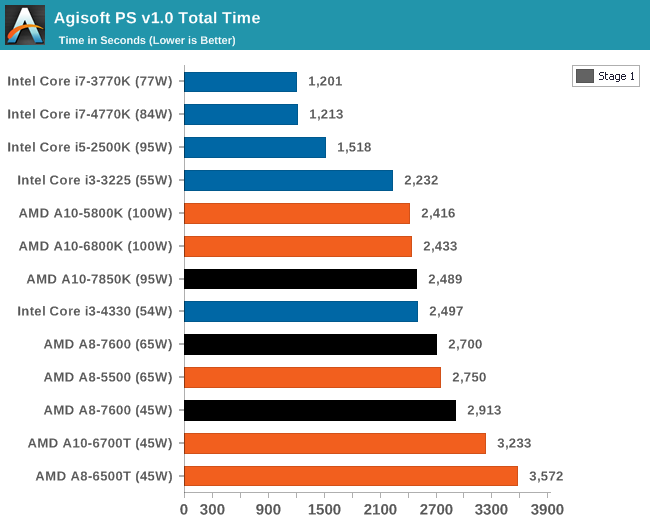
AMD suffers in overall time due to the lack of full-blooded cores and the reliance on single threaded performance in certain parts of the algorithm.
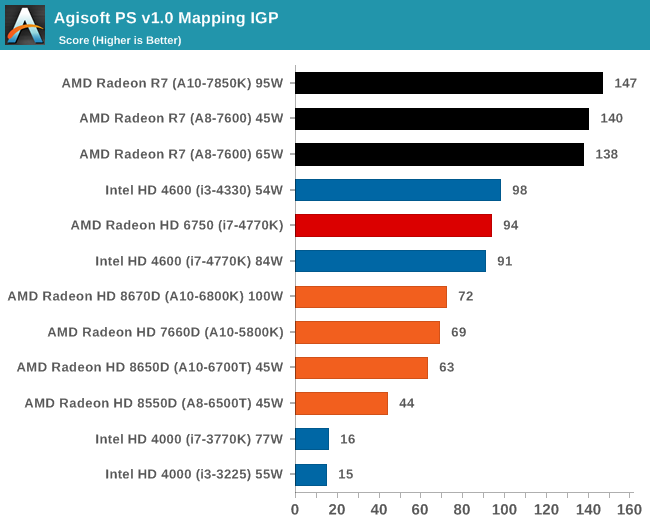
The second stage of the benchmark can be accelerated by the IGP of an APU, and as a result we can see the power of the high end APUs for this work can outshine any CPU we tested today. This is really the promise of HSA, it's just going to take a while to get there for most apps.
3D Particle Movement - link
3DPM is a self-penned benchmark, taking basic 3D movement algorithms used in Brownian Motion simulations and testing them for speed. High floating point performance, MHz and IPC wins in the single thread version, whereas the multithread version has to handle the threads and loves more cores.
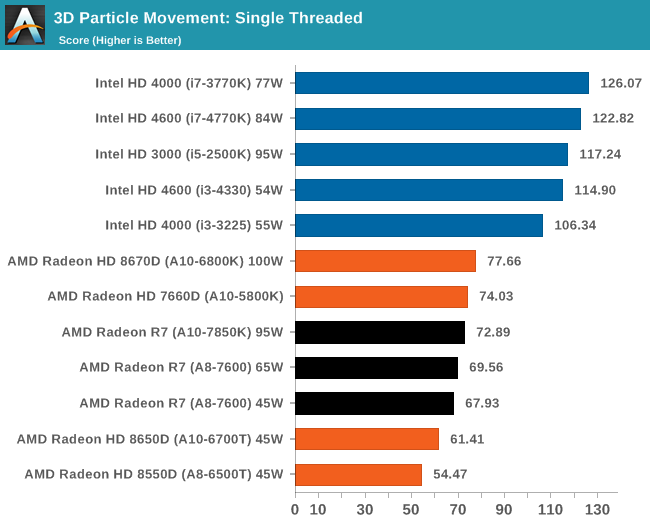
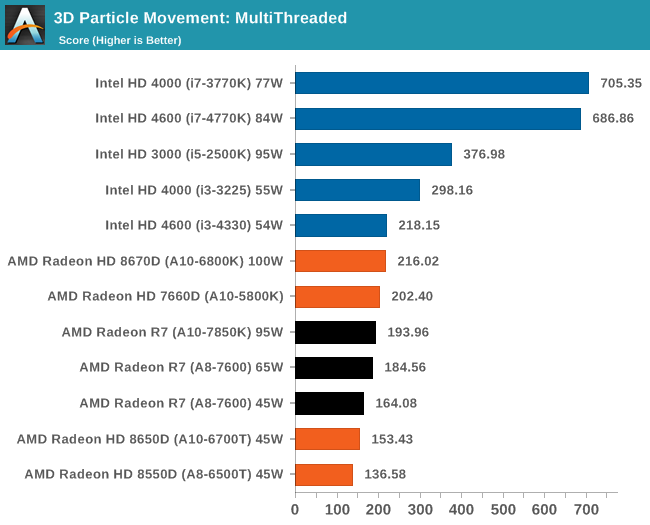
AMD is still suffering a lack of FP performance in our 3DPM benchmark.
WinRAR 5.01 - link
Our WinRAR test from 2013 is updated to the latest version of WinRAR at the start of 2014. We compress a set of 2867 files across 320 folders totaling 1.52 GB in size – 95% of these files are small typical website files, and the rest (90% of the size) are small 30 second 720p videos.
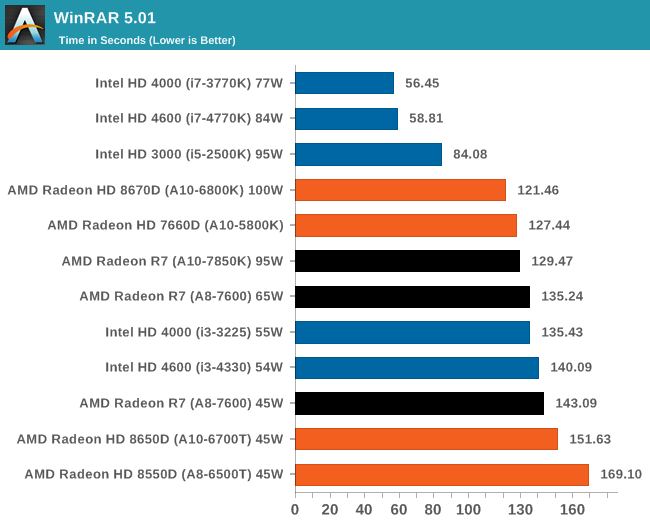
WinRAR loves IPC from the high end Intel chips, but even against the older i5-2500K there is still a deficit. The 45W Kaveri APU however is within fighting distance of its main rival.
FastStone Image Viewer 4.9 - link
Similarly to WinRAR, the FastStone test us updated for 2014 to the latest version. FastStone is the program I use to perform quick or bulk actions on images, such as resizing, adjusting for color and cropping. In our test we take a series of 170 images in various sizes and formats and convert them all into 640x480 .gif files, maintaining the aspect ratio. FastStone does not use multithreading for this test, and thus single threaded performance is often the winner.
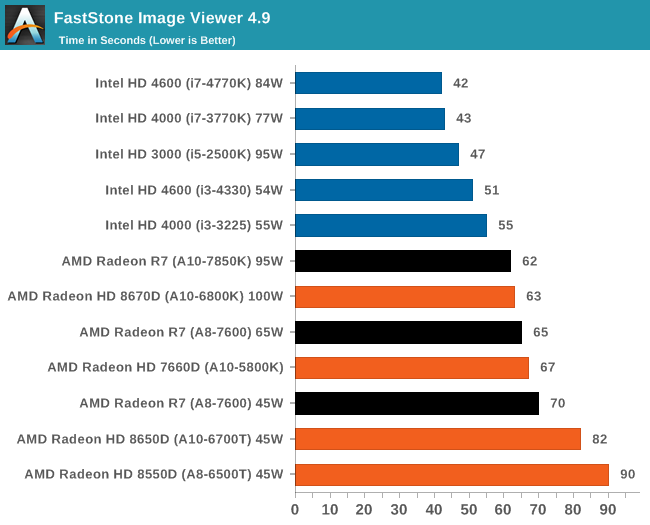
FastStone wants single threaded performance, so Intel wins here again.










380 Comments
View All Comments
DanNeely - Tuesday, January 14, 2014 - link
This is the first I've heard that Excavator will be the end of the line for the current AMD core. Is there any information about what's coming next publicly available yet?JDG1980 - Tuesday, January 14, 2014 - link
It's all speculation because AMD hasn't released any roadmaps that far in advance. If I had to guess, I'd say they will probably beef up the "cat" cores (Bobcat -> Jaguar, etc.) and use that as their mainstream line. That would be similar to what Intel did when they were faced with a situation like this - they scaled up the mobile Pentium M to become the Core 2 Duo.jabber - Tuesday, January 14, 2014 - link
The great shame of these chips is the real market they should be selling in will never take off. These are perfect all round chips for those folks that buy a family PC in the usual PC mega store. That family PC would be your usual Compaq/Acer desktop with a decent enough Intel chip in it but the crappy Intel IGP only.But as AMD never advertises to these people (the people who should be buying this stuff) they will never buy them. The demand will never appear. They have heard of Intel, they hear the Intel jingle on the TV several times a week. But AMD? Never heard of them, they cant be any good.
Has anyone at Anandtech ever got round to interview the lazy idiot in the AMD marketing dept? Does AMD really have a marketing dept?
AMD, sometimes you do have to push the boat out and make the effort. Really stick it under ordinary peoples noses. Don't bother keep brown-nosing the tech review sites cos most of their readers don't buy your stuff anyway.
UtilityMax - Tuesday, January 14, 2014 - link
AMD can't market the APUs directly to the average consumers. They just buy what the PC mega-store sells to them. AMD should convince the OEMs, and that is _really_ hard. First is the issue of Intel quasi-monopoly. Intel always browbeat the major EOMs to ignore AMD. Even after losing the lawsuit, I think this effect still exists. And then next issue is that, your typical average consumer does not play on PC. They play on consoles. In fact, hardly anyone buys a PC box these days. Everyone buys laptops, and AMD's strategy there is just as weak.ThreeDee912 - Tuesday, January 14, 2014 - link
They tried to get OEMs to put Llano chips into "thin and light" laptops, but Intel kind of beat them with their Ultrabook marketing.At least AMD kind of "won" the console wars by getting their CPUs into both the PS4 and XBone.
xdesire - Tuesday, January 14, 2014 - link
Sorry but i read it like this: this is another piece of sht hardware which is YET another disappointment for their fans. I owned many of their CPUs GPUs and stuff but enough is enough. They have been laying their a**es off for SO long and couldn't even make an improvement on their crap stuff. So, is this THE Kaveri we were promised for so long? I supported them in their worst days by buying their products, hoping to see them come back in the game BUT no, they are being lazy and don't improve sht..jabber - Tuesday, January 14, 2014 - link
Dear AMD marketing Dept, the above post signifies what I said in the last part of my last post.This is not the market/customer you are looking for!
jnad32 - Tuesday, January 14, 2014 - link
Actually a 30% performance improvement seems pretty amazing to me. Also please try and remember that all these tests are done with very early drivers. We all know AMD takes forever to get there drivers in line. I wouldn't personally worry about numbers for the next couple of months. BTW, what were you expecting from an APU? Core i5? HA! I am a massive AMD fan, but we all know that wasn't even possible. What I really want to know is where is my 8 core Steamroller chip.JDG1980 - Tuesday, January 14, 2014 - link
I was hoping for IPC in line with at least Nehalem. The low IPC is really killing the "construction equipment" cores, and it's increasingly looking like an unfixable problem. If Steamroller could have brought ~30% IPC gains as was initially rumored, then that would have been a good sign, but at this point it seems they'd be better off taking their "cat" cores and scaling them up to desktop levels, and dropping the module architecture as a failed experiment.silverblue - Tuesday, January 14, 2014 - link
A "construction equipment" (thanks) module actually gets an impressive amount of work done when taxed. The concensus has been to make software think a module is a single core with HT. I imagine that the cores will be fed better in single threaded workloads in that circumstance.I also imagine that a heavily threaded workload will extract the very best from the architecture now the MT penalty is gone.
One question about the review scores - all the testing was done on Windows 7 64-bit SP1 with the Core Parking updates applied. Would using Windows 8 or 8.1 make any real difference to the results or would it just benefit both AMD and Intel?